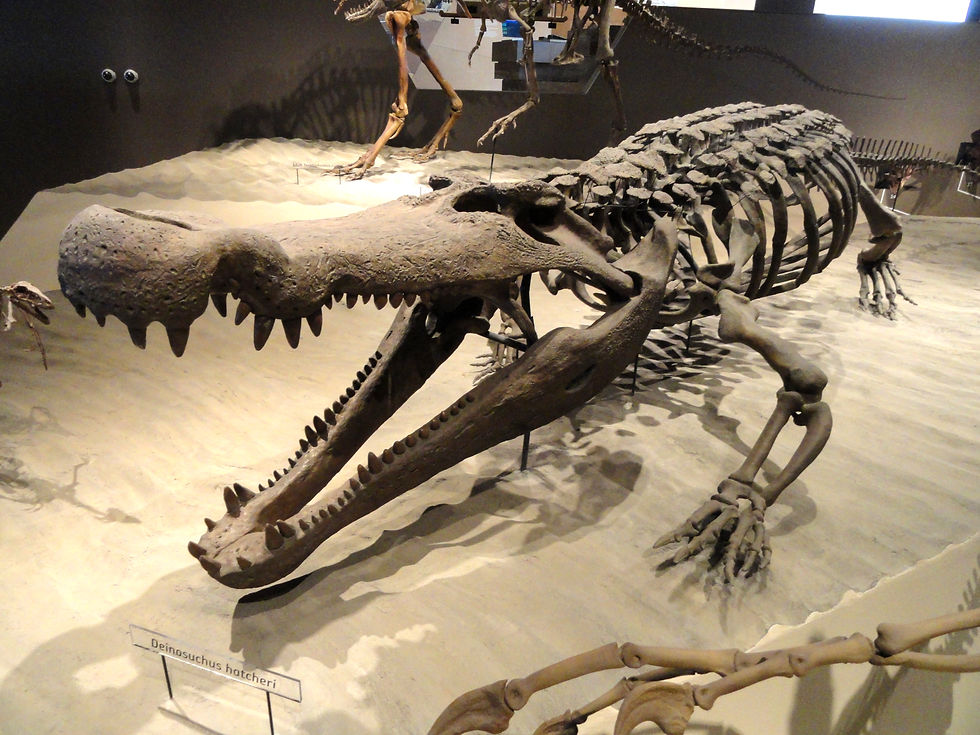Mary Anning The Jurassic Coast's Pioneering Palaeontologist and Fossil Collector
- Wayne Munday
- Feb 15, 2022
- 6 min read
Exploring the history of women in earth science it is interesting to discover who else along with Mary Anning were the agents of change during the Georgian, Regency and early Victorian era and whose legacy is credited today with progressive advancement in this field.

Ichthyosaurus (‘fish lizard’)
To take on the greatest scientific challenges of the day means harnessing all the available talent in an inclusive and diverse way. Unfortunately, history has shown that access and participation to science has not always been gender or class neutral.
Mary Anning, was born in May 1799 in Lyme Regis, Dorset. She was self-educated and she would become recognised as one of Britain’s most influential scientists as a pioneering geologist, palaeontologist and fossil collector with her discoveries along the Jurassic Coast.

Mary Anning (image right with dog Tray) famously discovered with her brother Joseph the first ichthyosaurus (‘fish lizard’) specimen in 1812 aged only 12; the first complete long-necked marine reptile called a plesiosaurus in 1823; the first British example of a pterodactyl or flying reptile called a Dimorphodon in 1828 and in 1829 she excavated the skeleton of a Squaloraja, a fossil fish thought to be a member of a transition group between sharks and rays.
News of Mary Anning’s fossil excavations made her popular and prompted palaeontologists, collectors, and tourists to travel to Lyme Regis to buy specimens from her. It was fashionable at the time for affluent Georgians to seek out and collect curiosities such as fossils.
At the time Mary Anning was often not given full credit for many of the fossils she had discovered and sold. Some of her customers unscrupulously credited themselves with specimens they had bought and go onto donate to museums or featured in scientific journals.

Two notable exceptions was the British Geologist Sir Henry Thomas De la Beche (image left). He was first director of the Geological Survey of Great Britain. Also British palaeontologist Gideon Algernon Mantell known for his discovery of several genera of dinosaurs and palaeontology of the Mesozoic Era in Sussex.
Both gentlemen credited Mary Anning for the exceptional specimens that they now owned.
Mary Anning was born during the warring realm of King George III, The Prince Regent and who died in 1847 from breast cancer nine years after the coronation of Queen Victoria.
This was a period of history characterised as having a class-based society dominated by wealthy men. During the Victorian era both gender and social class prevented many women, including Mary Anning from formally contributing to the scientific community.
During the 18th and 19th centuries women’s access to science was limited, and science was regarded as a hobby or an indulgence only for intelligent wealthy women. Early female scientists were often born into influential families. They collected fossils and mineral specimens, and were occasionally allowed to attend scientific lectures, but they were barred from membership in scientific societies. The Geological Society of London refused to admit Mary Anning and they didn't admit women until 1904.

Women have played significant and influential roles in the study of geology and paleoethology. However, Victorian thinking is best illustrated as to why their contributions were so diminished at the time in a letter dated March 1860 from Thomas Henry Huxley to Scottish geologist Sir Charles Lyell (image right):
“Five-sixths of women will stop in the doll stage of evolution, to be the stronghold of parsonism, the drag on civilisation, the degradation of every important pursuit in which they mix themselves – intrigues in politics and friponnes in science.”
Mary Anning was not alone at this time in the pursuit of studying the earth sciences and other influential women of the time included:

Barbara Rawdon-Hastings (née Yelverton - image left), Marchioness of Hastings, 20th Baroness Grey de Ruthyn who between 1839 and 1850 collected specimens of fossil crocodiles and turtles from the Hampshire cliffs and the Isle of Wight. The collection is now in the Natural History Museum.
Etheldred Bennet (1776 - 1845) was from Warminster in Wiltshire and is often described as the ‘Mother of English Geology’. Etheldred is credited with producing the first annotated bed-by-bed section of the Chicksgrove Quarry near Tisbury where stone from the Purbeck and Portland beds in the Vale of Wardour revealed a unique range of fossil plant and reptile remains. A relation of her eldest brother John was Aylmer Bourke Lambert an original fellow of the Linnean Society, a Fellow of the Royal Society and an early member of the Geological Society. He was well known as a botanist and geologist and encouraged Etheldred and her sister Anna Maria to study natural history. Etheldred took up the study of fossils, while her sister took up botany. Etheldred published her catalogue of the organic remains of the county of Wiltshire in 1831, naming and figuring several new species, including the sponge Polypothecia quicequeloba.
Mary, Elizabeth and Margaret Philpot who relocated to Lyme Regis in 1805 and who lived in the now Mariner’s Hotel. The sisters, especially Elizabeth Philpot, were noted for their fossil collecting and relationship with Mary Anning. The sisters are fondly referred to as “The Philpot sisters”.
Mary Buckland née Morland (1797-1857) was born in Marcham in 1797, the daughter of an Abingdon lawyer Benjamin Morland and wife to William Buckland (1784-1856), an Oxford clergyman. William Buckland had turned to geology in the hope of reconciling the fossil record with the Biblical creation narrative. Mary Buckland was a skilled scientific illustrator, collaborator, curator of specimens, and assistant to her husband. Mary provided scientific illustrations to a number of eminent scientists such as William Daniel Conybeare the English geologist and palaeontologist, known for his classic work on the stratigraphy of the Carboniferous period and the French Baron George Cuvier, a zoologist, and who established the sciences of comparative anatomy and palaeontology and the idea of catastrophism. Mary Buckland is now credited (not at the time) for the joint achievement with her husband in publishing the book Geology and Mineralogy (1836) where the biblical interpretation of the fossil record was definitively abandoned.

Charlotte Murchison neé Hugonin (image right) was born in 1788 in Hampshire and became a friend to Mary Anning, The Philpot Sisters and Mary Somerville. Charlotte is credited for her collaboration with Sir Charles Lyell during a grand tour of Italy collecting and documenting fossils that would prove that the valleys of the Auvergne had been excavated by the gradual action of rivers, over the course of millennia, and had not been created in a single catastrophic incident.
Elizabeth Cobbold neé Knipe (1764-1824) was a well-educated woman and polymath of both the arts and sciences. She married John Cobbold (1746-1835), a prominent Ipswich brewer, who gave her the money and the contacts to progress her scientific ambitions. Elizabeth is credited for collecting and identifying fossils from the Suffolk Crag (now known as the Red Crag deposits). Her fossil specimens were first published by James Sowerby in his Mineral Conchology in 1813 that proceeded the first paper on Mary Anning’s specimens published by the Geological Society.
Mary Sommerville née Fairfax (1780 – 1872) from Jedburgh in Scotland and daughter of Admiral Sir William George Fairfax. Mary studied mathematics and astronomy, and in 1835 jointly became the first female member of the Royal Astronomical Society along with Caroline Herschel the first woman to discover a comet. Mary Sommerville is credited with translating into English, Pierre-Simon Laplace’s book, “Exposition du système du monde and the Méchanique celeste” on behalf of Lord Brougham of the Society for the Diffusion of Useful Knowledge.

Jane Marcet, née Haldimand (1769 – 1858 - image left) is credited as the first female science writer known for her accessible educational books including "Conversations on Chemistry" published in 1806. This book would become the standard text in chemistry education in Britain and overseas. The scientist Michael Faraday credits reading “Conversations on Chemistry” for giving him the first notions of electricity and his foundation in science.
Delvalle Elizabeth Rebecca Varley née Lowry (1800-1860) was born in London to the engraver and mineralogist lecturer Wilson Lowry. Delvalle was home educated in science and is credited as a British geologist, mineralogist and author who popularised mineralogy for a general audience with her first book, “Conversations on Mineralogy”.
Arabella Burton Buckley (1840–1929). Arabella was famously the secretary to the English geologist Sir Charles Lyell until his death in 1875. Her role was to research scientific information, some of which was used by Charles Darwin. She believed that evolution theory and a belief in God were not inherently antagonistic. She would go onto lecture on scientific matters and published educational materials for children, including The fairyland of science (1879), Through magic glasses and other lectures, a sequel to ’The fairy-land of science’ (1880), Life and her children (1881), Winners in life’s race, or, The great backboned family (1882), and A short history of natural science and of the progress of discovery from the time of the Greeks (1882).
Margaret Benson (1865-1916) was daughter of Edward White Benson, Archbishop of Canterbury who in 1985 was granted permission to excavate the Mut Temple Precinct at Karnak with Janet Gourlay making her the first woman to conduct her own excavation in Egypt and credited with the Benson Head archaeological find.
Portrait Images - Courtesy of Wikipedia and Wikimedia Commons







